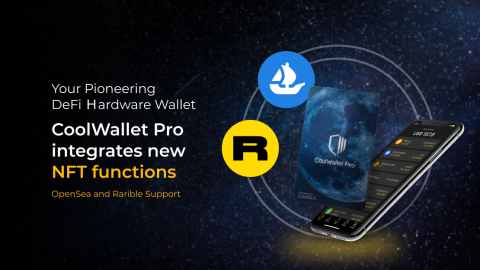Table of Contents
Introduction
CoolWallet is excited to announce that we are developing support for Bitcoin Nested SegWit (BIP49) in our CoolWallet Pro hardware wallet, alongside other previous upgrades like Bitcoin Native and Custom SegWit. Bitcoin Nested Segwit serves as a bridge between legacy and new BTC address formats. Also in the current pipeline is support for the Taproot upgrade. Please note that our entry-level model CoolWallet S will not support BIP49.
Here’s a quick primer on the different Bitcoin address formats, BIP49, and why they’re important.
CoolWallet Integrates Bitcoin Nested SegWit (BIP49)

CoolWallet has supported legacy addresses since our first Bitcoin-only mobile hardware wallet (the first of its kind) launched in 2016. Now, it’s time to support Nested Bitcoin Segwit, the bridge between the two.
With the integration of Bitcoin Nested SegWit (BIP49), CoolWallet users can now enjoy enhanced security through multi-signature transactions and reduced transaction fees. This initiative is part of our commitment to providing secure and user-friendly transaction processes.
Bitcoin Address Formats

Have you noticed that not all BTC addresses with the same letters and numbers? Unlike Ethereum and EVM chain addresses which all begin with “0x”?
That’s because Bitcoin addresses come in three main formats:
- Legacy (P2PKH) Addresses: Original format, addresses start with “1”.
- Nested SegWit (P2SH) Addresses: Bridging format, addresses start with “3”, offering reduced fees and enhanced security.
- Native SegWit (Bech32) Addresses: Latest format, addresses start with “bc1q” (Taproot addresses use”bc1p”), offering the lowest fees.
What are Nested SegWit (P2SH) Addresses?
Nested SegWit (P2SH) addresses are a type of Bitcoin address that starts with the number “3”. They were born out of the Segregated Witness (SegWit) protocol upgrade and offer reduced fees and enhanced security through multi-signature capabilities. They are the middle ground between Legacy and Native SegWit addresses, providing some (but not all) of the benefits of Native SegWit.
They are called “nested” because they combine two address formats: Pay-to-Script-Hash (P2SH) and Pay-to-Witness-Public-Key-Hash (P2WPKH).
- P2SH is an address format that allows for more complex transactions, such as multi-signature transactions (see CoolWallet’s Gnosis integration).
- P2WPKH is a SegWit address format that separates the transaction signature data from the transaction data, reducing the size of each transaction.
This combination allows Nested SegWit addresses to offer the best of both worlds: better safety and cheaper transactions.
Bitcoin Improvement Proposal (BIP) 49 defines the standard derivation path for wallets that generate Wrapped SegWit (P2SH-P2WPKH) addresses.
What’s the Purpose of Nested SegWit (P2SH) Addresses?
Here are some reasons why we need Nested SegWit addresses:
Enhanced security
Nested SegWit addresses mean multiple signatures are required to authorize transactions, making it more difficult for hackers to steal funds.
Lower transaction fees
Nested SegWit addresses can result in lower transaction fees due to their compatibility with the Segregated Witness (SegWit) protocol, which helps reduce the size of transactions on the Bitcoin blockchain. Your P2SH-wrapped SegWit address however is still compatible with wallets and exchanges that don’t yet support native SegWit addresses.

DELIVERED EVERY WEEK
Subscribe to our Top Crypto News weekly newsletter
Compatibility with older systems
Nested SegWit addresses are compatible with older systems, ensuring interoperability between different Bitcoin wallets. This makes them a pragmatic choice for those navigating the Bitcoin landscape. This is important because Bitcoin has a hardcore HODL community who are happy to keep their Bitcoin for decades ( if not life) in the same wallet without moving it. Ask Satoshi Nakamoto: the Bitcoin creators have a Bitcoin wallet with 1 million BTC in it.
What is a Bitcoin Improvement Proposal (BIP)?
A Bitcoin Improvement Proposal (BIP) is a formal suggestion for modifying Bitcoin. BIPs can recommend changes to Bitcoin’s rules, community guidelines, or the development process. These proposals come from Bitcoin community members and are sent to the Bitcoin Core development team for examination.
Upon review, if the Bitcoin Core development team approves a BIP, it goes for a community vote. If the community approves, the change is incorporated into the Bitcoin software. Significant Bitcoin modifications like Segregated Witness (SegWit) and Taproot were introduced through BIPs. BIPs are crucial for developing new Bitcoin features and standards.
BIP49 defines the standard derivation path for wallets that generate Wrapped SegWit (P2SH-P2WPKH) addresses. According to BIP 49, wallets that generate Wrapped SegWit addresses should use a derivation path beginning with “m/49’/”. This means the first address generated by a mainnet Bitcoin wallet will have a derivation path of “m/49’/0’/0’/0/0”.
Other chains have copied the BIP naming, for example, Ethereum’s is called EIP (see updates like EIP1559 and EIP4337).
Understanding Bitcoin Segregated Witness (SegWit)
Bitcoin SegWit, or Segregated Witness, is a soft fork upgrade to the Bitcoin protocol that was activated in August 2017. Overall, SegWit is a major upgrade to the Bitcoin protocol that has improved the scalability, security, and privacy of the network.
SegWit was designed to address two main issues: transaction malleability and block size limits.
Transaction malleability is a bug in the original Bitcoin protocol that allows anyone to change the unique ID of a Bitcoin transaction before it is confirmed on the network which could result in double spending of coins or transactions getting stuck in the mempool. SegWit fixes transaction malleability by moving the witness data, which contains the signatures for a transaction, to a separate part of the block.
SegWit doesn’t directly increase the block size limit, but it improves the efficiency of data storage within blocks, effectively allowing more transactions to be included in each block.
Furthermore, SegWit also enables a number of other features, such as the Lightning Network and Bitcoin Taproot.
Bitcoin Taproot is a privacy-enhancing upgrade that enables smart contract features like Ordinals and BRC20 and makes it more difficult to track Bitcoin transactions.
The Lightning Network is Bitcoin’s famous layer-2 payment protocol that allows the network to scale and helps users to make instant Bitcoin payments with very low fees.
Conclusion
Our coming support for Bitcoin Nested SegWit (BIP49) is a significant step towards fostering a secure and cost-efficient transaction environment for CoolWallet users. This integration, along with the continued support for other SegWit standards, showcases our dedication to catering to the evolving needs of our community. Let’s HODL together safely!




